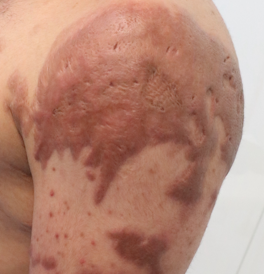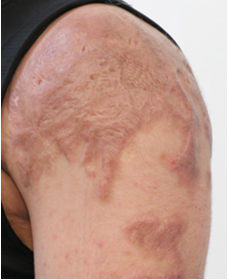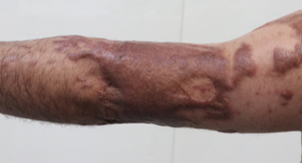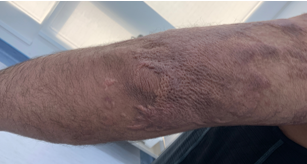Definition
Burn scars are a result of the body’s natural healing process following injuries caused by heat, chemicals, sunlight, electricity, or radiation.
Causes of burn scares
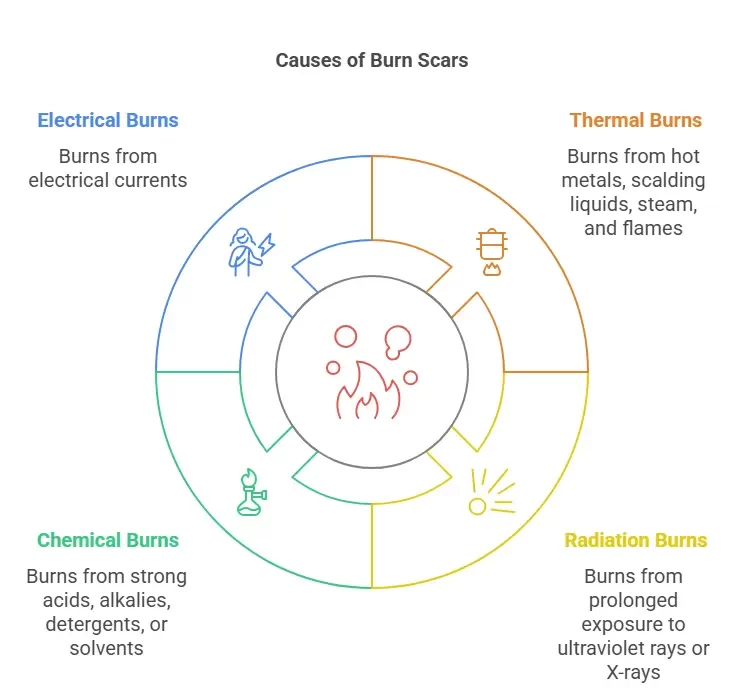
Burns can be a result of various causes, including thermal sources (like hot metals, scalding liquids, steam, and flames), radiation (prolonged exposure to ultraviolet rays or X-rays), chemicals (strong acids, alkalies, detergents, or solvents), and electrical currents.
Types Of Burns
1- First-degree burns: These are mild, affecting only the epidermis.
2-Second-degree burns: These affect both the epidermis and the dermis (lower skin layer). Symptoms include pain, redness, swelling, and blistering
3- Third-degree burns: These burns affect all three skin layers: epidermis, dermis, and fat. They also destroy hair follicles and sweat glands.
4- Fourth-degree burns: These burns not only destroy all skin layers but also damage underlying bones, muscles, and tendons.
Pathophysiology Of Burn Injuries
1- Immediate Response
2- Inflammatory Response
3- Collagen Production
4- Scar Formation
5- Maturation and Remodeling
6- Complications
EPIDEMIOLOGY
Prevalence and Factors: Unintentional burn injuries are common due to cooking fires and cultural practices.
Limited access to quality burn care exacerbates the issue.
Impact on Quality of Life: Burn injuries result in physical limitations, social isolation, and psychological distress.
Epidemiology of Burn Scars: Burn scars, a frequent outcome, affect approximately 10% of the global population.
They cause physical symptoms and significant psychological distress.
Significance: Burn scars represent a major public health concern, affecting around 100 million people globally.
In the Middle East and GCC, around 1 million people are affected, emphasizing a regional health issue.
INTEGRATION OF TISSUE ENGINEERING IN BURN SCAR MANAGEMENT
Biologically active dressings
Application of engineered skin substitutes or scaffolds
Implementation of advanced matrices
INNOVATION IN THE FIELD
Our R&D team has pioneered proprietary tissue scaffolding techniques that hold the promise of revolutionizing burn scar treatment.
1- Bioengineered Materials
2- Tissue Scaffolding
3- Regeneration with Minimal Scarring
ROLE OF EVERLAST WELLNESS GROUP AND THE TISSUE BIOENGINEERING DIVISION
1- Collaborative Research:
The tissue bioengineering division will work closely with Everlast Wellness Group’s other departments to ensure a holistic approach to burn scar treatment.
This collaboration will involve sharing insights, resources, and expertise.
2- Clinical Trials:
Before introducing
our innovations to a broader audience,
we will conduct rigorous clinical trials. These trials
will assess the safety, efficacy, and potential side effects of our tissue
scaffolding techniques.
3- Patient Education:
Everlast Wellness Group will take the lead in
educating patients about this new treatment option. Through seminars,
workshops, and one-on-one consultations, we aim to inform patients
about the benefits and potential risks.
4- Continuous Improvement:
Leveraging feedback from both patients
and healthcare professionals, we will continuously refine our techniques.
Our goal is to ensure that we remain at the cutting edge of burn scar treatment.
5- Global Outreach:
Recognizing the global prevalence of burn injuries,
Everlast Wellness Group plans to collaborate with international medical
institutions. This will allow us to bring our innovative solutions to patients worldwide
Case Studies (Before&After)
